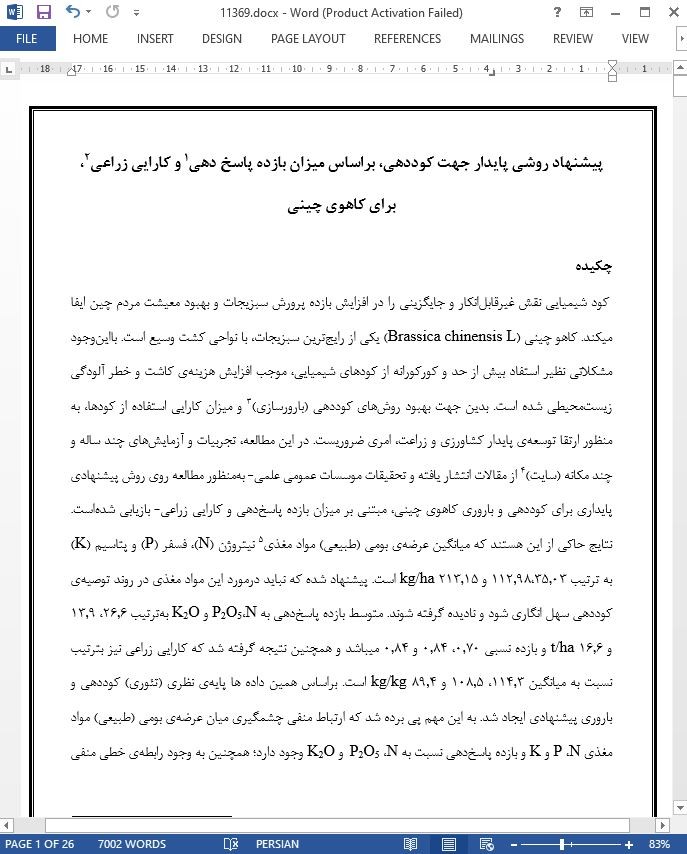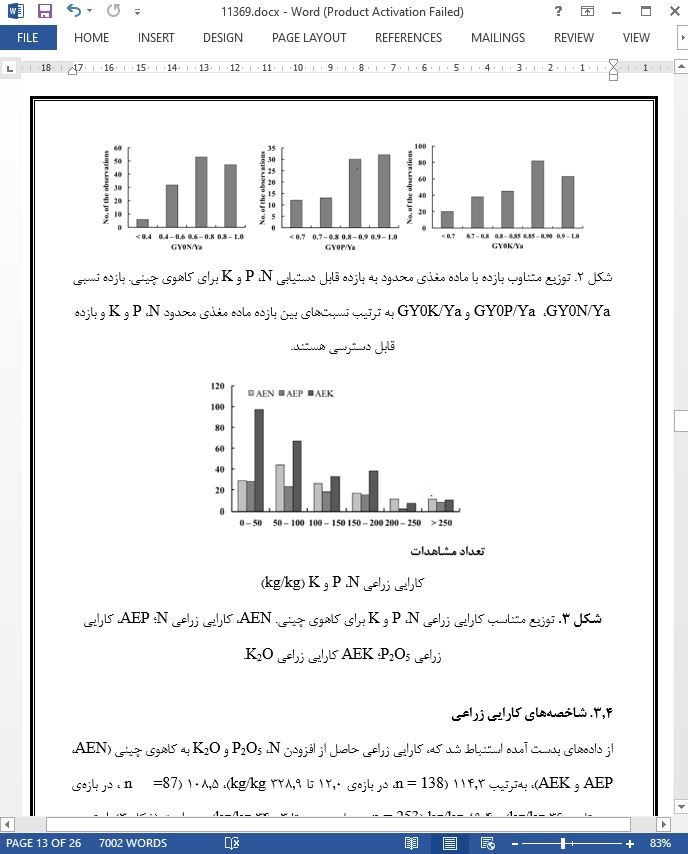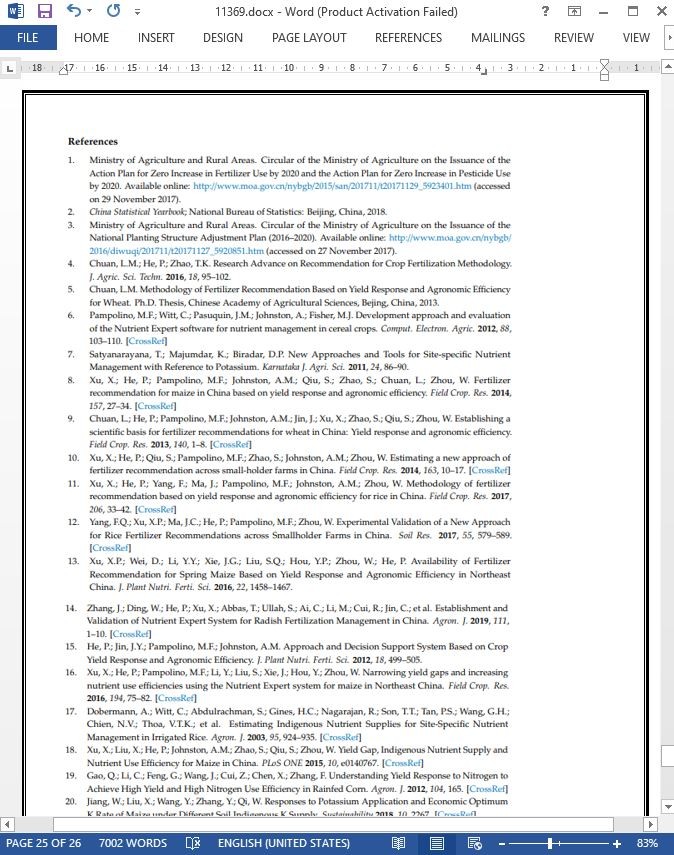
پیشنهاد روشی پایدار جهت کوددهی، بر اساس میزان بازده پاسخ دهی و کارایی زراعی
چکیده
کود شیمیایی نقش غیرقابلانکار و جایگزینی را در افزایش بازده پرورش سبزیجات و بهبود معیشت مردم چین ایفا میکند. کاهو چینی (Brassica chinensis L) یکی از رایجترین سبزیجات، با نواحی کشت وسیع است. بااینوجود مشکلاتی نظیر استفاد بیش از حد و کورکورانه از کودهای شیمیایی، موجب افزایش هزینهی کاشت و خطر آلودگی زیستمحیطی شده است. بدین جهت بهبود روشهای کوددهی (بارورسازی) و میزان کارایی استفاده از کودها، به منظور ارتقا توسعهی پایدار کشاورزی و زراعت، امری ضروریست. در این مطالعه، تجربیات و آزمایشهای چند ساله و چند مکانه (سایت) از مقالات انتشار یافته و تحقیقات موسسات عمومی علمی- بهمنظور مطالعه روی روش پیشنهادی پایداری برای کوددهی و باروری کاهوی چینی، مبتنی بر میزان بازده پاسخدهی و کارایی زراعی- بازیابی شدهاست. نتایج حاکی از این هستند که میانگین عرضهی بومی (طبیعی) مواد مغذی نیتروژن (N)، فسفر (P) و پتاسیم (K) به ترتیب 112.98،35.03 و 213.15 kg/ha است. پیشنهاد شده که نباید درمورد این مواد مغذی در روند توصیهی کوددهی سهل انگاری شود و نادیده گرفته شوند. متوسط بازده پاسخدهی به N،P2O5 و K2O بهترتیب 26.6، 13.9 و 16.6 t/ha و بازده نسبی 0.70، 0.84 و 0.84 میباشد و همچنین نتیجه گرفته شد که کارایی زراعی نیز بترتیب نسبت به میانگین 114.3، 108.5 و 89.4 kg/kg است. براساس همین داده ها پایهی نظری (تئوری) کوددهی و باروری پیشنهادی ایجاد شد. به این مهم پی برده شد که ارتباط منفی چشمگیری میان عرضهی بومی (طبیعی) مواد مغذی N، P و K و بازده پاسخدهی نسبت به N، P2O5 و K2O وجود دارد؛ همچنین به وجود رابطهی خطی منفی مشهودی میان بازده پاسخدهی و بازده نسبی N، P2O5 و K2O پیبرده شد. بعلاوه، درمورد کاهوی چینی رابطهی تک بعدی درجهی دوم مشهودی میان بازده پاسخدهی و کارایی زراعی وجود دارد. سپس آزمایشهای میدانی دو سالهای بهمنظور حصول تایید در مورد توصیهی کوددهی و بارورسازی، بر روی کاهوی چینی صورت گرفت. این نتیجه گرفته شد که توصیه های کوددهی برای کاهوی چینی براساس بازده پاسخدهی و کارایی زراعی، روشی پایدار برای بکارگیری زمین های زراعتی است و نهتنها از لحاظ اقتصادی به صرفه است و بهکارگیری آن در زمین هایی با مساحت های متفاوت آسان، بلکه در نظر گرفتن عرضهی بومی مواد مغذی و برهمکنش میان N، P و K نشانگر مزایای کارایی بالای این روش است؛ علیالخصوص هنگامی که شرایطی از قبیل آزمایش خاک و تشخیص نباتی کافی نباشند.
5. نتیجه گیری
در این مطالعه، مطالعاتی چند مکانه و چند ساله از مقالات منتشر شده و موسسات تحقیقاتی علمی عمومی، بهجهت مطالعه برروی روشی پایدار برای توصیهی کوددهی برای کاهوی چینی مبتنی بر بازده پاسخدهی و کارایی زراعی، بازیابی شده است. نتایج حاکی از آنند که میانگین عرضهی بومی مادهی مغذی N، P و K به ترتیب 112.98، 35.03 و 213.15 kg/ha بوده که نمیتوان از این دادهها در هنگام توصیهی کوددهی چشم پوشی کرد. میانگین بازده پاسخدهی به N، P2O5 و K2O، 26.6، 13.9 و 16.6 t/ha؛ بازده نسبی 0.70، 0.84 و 0.84 بوده؛ همچنین استنباط شد که کاراییهای زراعی نسبت به میانگین، به ترتیب 114.3، 108.5 و 89.4 kg/kg بودند. از این دادهها، اصول تئوریک توصیهی کوددهی بدست آمد. معلوم شد که رابطهی منفی چشمگیری میان عرضهی بومی مادهی مغذی N، P و K و بازده پاسخدهی به N، P2O5 و K2O وجود دارد؛ همچنین رابطهی خطی منفیای نیز میان بازده پاسخدهی و بازده نسبی N، P2O5 و K2O در کاهوی چینی موجود است. همچنین رابطهی تک بعدی درجهی دوم قابل توجهی میان بازده پاسخدهی و کارایی زراعی برقرار است. سپس به مدت دوسال مطالعات میدانی روی کاهوی چینی صورت گرفت تا موید توصیهی کوددهی مبتنی بر بازده پاسخدهی و کارایی زراعی باشد. نتایج موید آن هستند که توصیهی کوددهی کاهوی چینی مبتنی بر بازده پاسخدهی و کارایی زراعی، بازده و سود ناخالص را افزایش میدهد و همچنین، کارایی زراعی و کارایی بازیابی را بهبود میبخشد که این، خود استفادهی پایدار از زمین زراعی است. این روش نه تنها از لحاظ اقتصادی و راحتی کاربرد در اراضی با اندازههای مختلف مناسب است، بلکه عرضهی بومی مواد مغذی و برهمکنش میان N، P و K را نیز درنظر میگیرد که این مهم، علیالخصوص هنگامیکه شرایطی از قبیل تست خاک و شناسایی نباتی کفایت نمیکنند، نشانگر مزایای کارایی بالای این روش میباشد.
Abstract
Chemical fertilizer plays an irreplaceable role in raising vegetable output and improving the livelihood of people in China. Chinese cabbage (Brassica chinensis L.) is one of the most common vegetables with a wide planting area. However, there are problems such as the excessive and blind application of chemical fertilizers, which bring about the increase of planting cost and the risk of environmental pollution. So, it is urgent to improve fertilization methods and improve fertilizer use efficiency, aiming to promote the sustainable development of agriculture. In this study, multi-year and multi-site experiments were retrieved from the published literature and public scientific research institutions to study a sustainable fertilizer recommendation method for Chinese cabbage based on yield response and agronomic efficiency. The results showed that the average indigenous nutrients supply of nitrogen (N), phosphorus (P), and potassium (K) were 112.98, 35.03, and 213.15 kg/ha, respectively. It is suggested that these nutrients should not be neglected in the process of fertilizer recommendation. The average yield responses to N, P2O5, and K2O were 26.6, 13.9, and 16.6 t/ha, the relative yields were 0.70, 0.84, and 0.84; also, it was concluded that the agronomic efficiencies were 114.3, 108.5, and 89.4 kg/kg on average, respectively. From these datasets, the theoretical basis of recommended fertilization was established. It was found that there was a significant negative correlation between N, P, and K indigenous nutrient supply and the yield response to N, P2O5, and K2O, and a significant negative linear correlation between yield response and the relative yield of N, P2O5, and K2O. There was also a significant one-dimensional quadratic function relationship between yield response and agronomic efficiency in Chinese cabbage. Then, two years of field experiments for Chinese cabbage were conducted to verify the fertilizer recommendation. It was concluded that fertilizer recommendation for Chinese cabbage based on yield response and agronomic efficiency was a sustainable way for farmland utilization, not only economically and suitably satisfying its application on fields of different sizes, but also taking into account the indigenous nutrient supply and the interaction between N, P, and K, having shown the advantages of high efficiency, especially when the conditions such as soil testing and plant diagnosis were not sufficient.
5. Conclusions
In this study, multi-year and multi-site experiments were retrieved from the published literature and public scientific research institutions to study a sustainable fertilizer recommendation method for Chinese cabbage based on yield response and agronomic efficiency. The results showed that the average indigenous nutrients supply of N, P, and K were 112.98, 35.03, and 213.15 kg/ha, respectively, which cannot be neglected when make fertilizer recommendations. The average yield responses to N, P2O5, and K2O were 26.6, 13.9, and 16.6 t/ha; the relative yields were 0.70, 0.84, and 0.84; also, it was concluded that the agronomic efficiencies were 114.3, 108.5, and 89.4 kg/kg on average, respectively. From these datasets, the theoretical basis of recommended fertilization was established. It was found that there was a significant negative correlation between N, P, and K indigenous nutrient supply and the yield response to N, P2O5, and K2O, and a significant negative linear correlation between yield response and the relative yield of N, P2O5, and K2O in Chinese cabbage. There was also a significant one-dimensional quadratic function relationship between yield response and agronomic efficiency in Chinese cabbage. Then two years of field experiments for Chinese cabbage were conducted to verify the fertilizer recommendation based on yield response and agronomic efficiency. The results showed that fertilizer recommendation of Chinese cabbage based on yield response and agronomic efficiency guaranteed or increased the yield and gross profit, also improved the agronomic efficiency and recovery efficiency, which is sustainable for farmland utilization. This method not only economically and suitably satisfies the application of recommended fertilization on fields of different sizes, but also takes into account the indigenous nutrient supply and the interaction between N, P, and K, showing the advantages of high efficiency, especially when the conditions such as soil testing and plant diagnosis are not sufficient.
چکیده
1.مقدمه
2.مواد و روش ها
2.1. منابع داده ها
2.2 مروری بر اعتبار سنجی میدانی
3. نتایج
3.1. شاخصههای عرضه بومی مواد مغذی خاک
3.2. مشخصههای بازده پاسخدهی
3.3. شاخصههای بازده نسبی
3.4. شاخصههای کارایی زراعی
3.5. رابطهی میان بازده پاسخدهی و عرضه بومی مواد مغذی
3.6. رابطهی میان بازده پاسخدهی و بازده نسبی
3.7. رابطهی میان بازده پاسخدهی و کارایی زراعی
3.8. اصول توصیه کوددهی و ارزیابی میدانی
4. بحث و گفتگو
4.1. عرضه بومی مواد مغذی خاک
4.2. خلا عملکرد برای محصول
4.3. روشهای توصیه کوددهی برای محصولات
5. نتیجه گیری
Abstract
1. Introduction
2. Materials and Methods
2.1. Data Source
2.2. Overview of Field Validation
3. Results
3.1. Characteristics of Soil Indigenous Nutrient Supply
3.2. Characteristics of Yield Response
3.3. Characteristics of Relative Yield
3.4. Characteristics of Agronomic Efficiency
3.5. Relationship between Yield Response and Indigenous Nutrient Supply
3.6. Relationship between Yield Response and Relative Yield
3.7. Relationship between Yield Response and Agronomic Efficiency
3.8. Principles of Fertilizer Recommendation and Field Validation
4. Discussion
4.1. Soil Indigenous Nutrient Supply
4.2. Yield Gaps for Crop
4.3. Methods of Fertilizer Recommendation for Crops
5. Conclusions
- اصل مقاله انگلیسی با فرمت ورد (word) با قابلیت ویرایش
- ترجمه فارسی مقاله با فرمت ورد (word) با قابلیت ویرایش، بدون آرم سایت ای ترجمه
- ترجمه فارسی مقاله با فرمت pdf، بدون آرم سایت ای ترجمه



